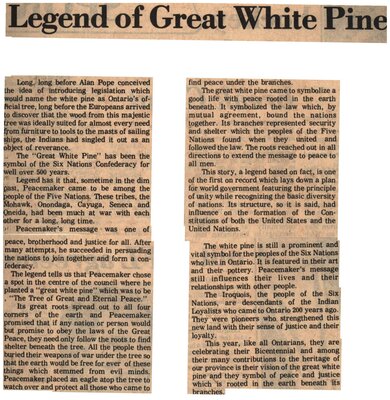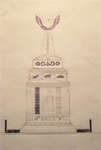"Legend of Great White Pine"
- Full Text
- Legend of Great White Pine
Long, long before Alan Pope conceived the idea of introducing legislation which would name the white pine as Ontario's official tree, long before the Europeans arrived to discover that the wood from this majestic tree was ideally suited for almost every need from furniture to fools to the masts of sailing ships, the Indians had singled it out as an object of reverance.
The "Great White Pine" has been the symbol of the Six Nations Confederacy for well over 500 years.
Legend has it that, sometime in the dim past, Peacemaker came to be among the people of the Five Nations. These tribes, the Mohawk, Onondaga, Cayuga, Seneca and Oneida, had been much at war with each other for a long, long time.
Peacemaker's message was one of peace, brotherhood and justice for all. After many attempts, he succeeded in persuading the nations to join together form a confederacy.
The legend tells us that Peacemaker chose a spot in the centre of the council where he planted a "great white pine" which was to be, "The Tree of Great and Eternal Peace."
Its great roots spread out to all four corners of the earth and Peacemaker promised that if any nation or person would but promise to obey the laws of the Great Peace, they need only follow the roots to find shelter beneath the tree. All the people then buried their weapons of war under the tree so that the earth would be free for ever of these things which stemmed from evil minds. Peacemaker placed an eagle atop the tree to watch over and protect all those who came to find peace under the branches.
The great white pine came to symbolize a good life with peace rooted in the earth beneath. It symbolized the law which, by mutual agreement, bound the nations together. Its branches represented security and shelter which the peoples of the Five Nations found when they united and followed the law. The roots reached out in all directions to extend the message to peace to all men.
This story, a legend based on fact, is one of the first on record which lays down a plan for world government featuring the principle of unity while recognizing the basic diversity of nations. Its structure, so it is said, had influence on the formation of the Constitutions of both the Untied States and the United Nations.
The white pine is still a prominent and vital symbol for the peoples of the Six Nations who live in Ontario. It is featured in their art and their pottery. Peacemaker's message still influences their lives and their relationships with other people.
The Iroquois, the people of the Six Nations, are descendants of the Indian Loyalists who came to Ontario 200 years ago. They were pioneers who strengthened this new land with their sense of justice and their loyalty.
This year, like all Ontarians, they are celebrating their Bicentennial and among their many contributions to the heritage of our province is their vision of the great white pine and they symbol of peace and justice which is rooted in the earth beneath its branches.
- Media Type
- Newspaper
- Item Types
- Articles
- Clippings
- Description
- "Long, long before Alan Pope conceived the idea of introducing legislation which would name the white pine as Ontario's official tree, long before the Europeans arrived to discover that the wood from this majestic tree was ideally suited for almost every need from furniture to tools to the masts of sailing ships, the Indian had singled it out as an object of reverence."
- Corporate Name(s)
- Six Nations Confederacy
- Local identifier
- SNPL002616v00d
- Collection
- Scrapbook #1 by Janet Heaslip
- Language of Item
- English
- Geographic Coverage
-
-
Ontario, Canada
Latitude: 43.06681 Longitude: -80.11635
-
- Creative Commons licence
 [more details]
[more details]- Copyright Statement
- Public domain: Copyright has expired according to Canadian law. No restrictions on use.
- Contact
- Six Nations Public LibraryEmail:info@snpl.ca
Website:
Agency street/mail address:1679 Chiefswood Rd
PO Box 149
Ohsweken, ON N0A 1M0
519-445-2954




